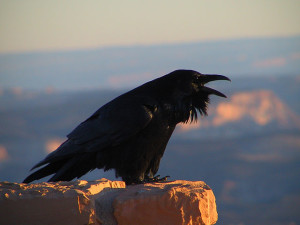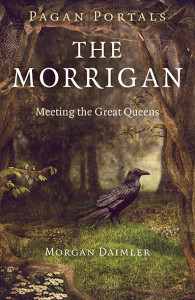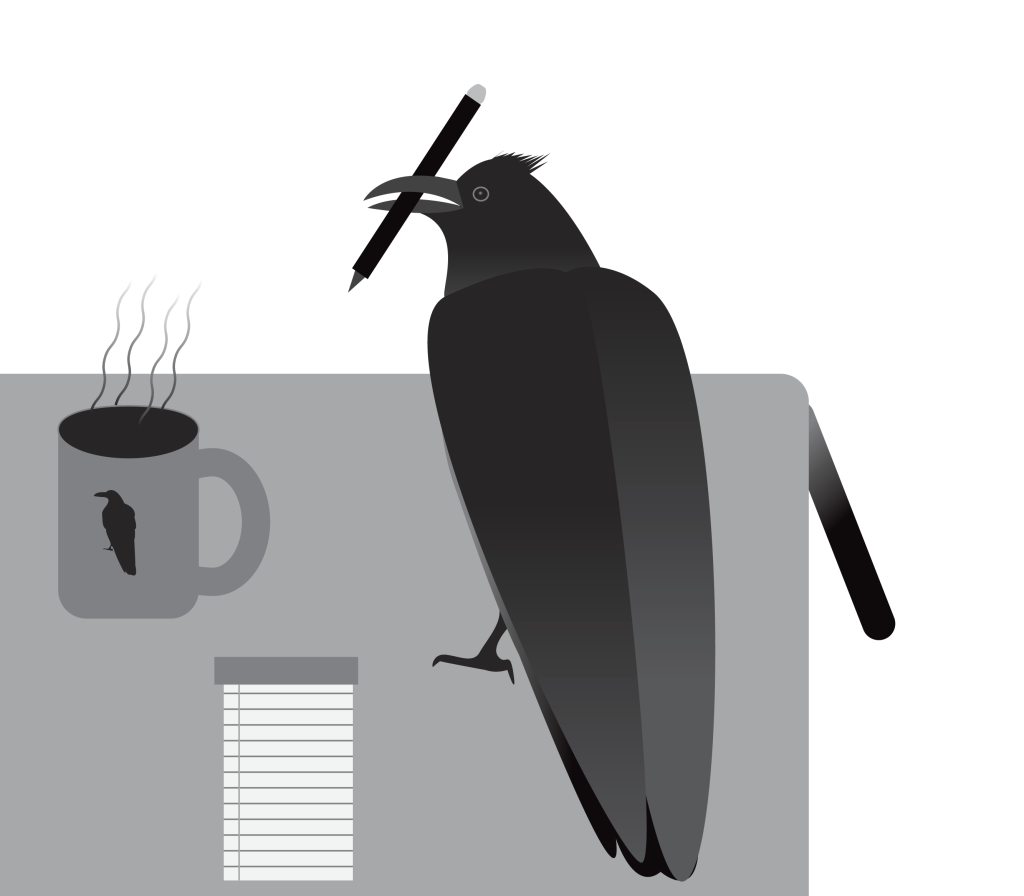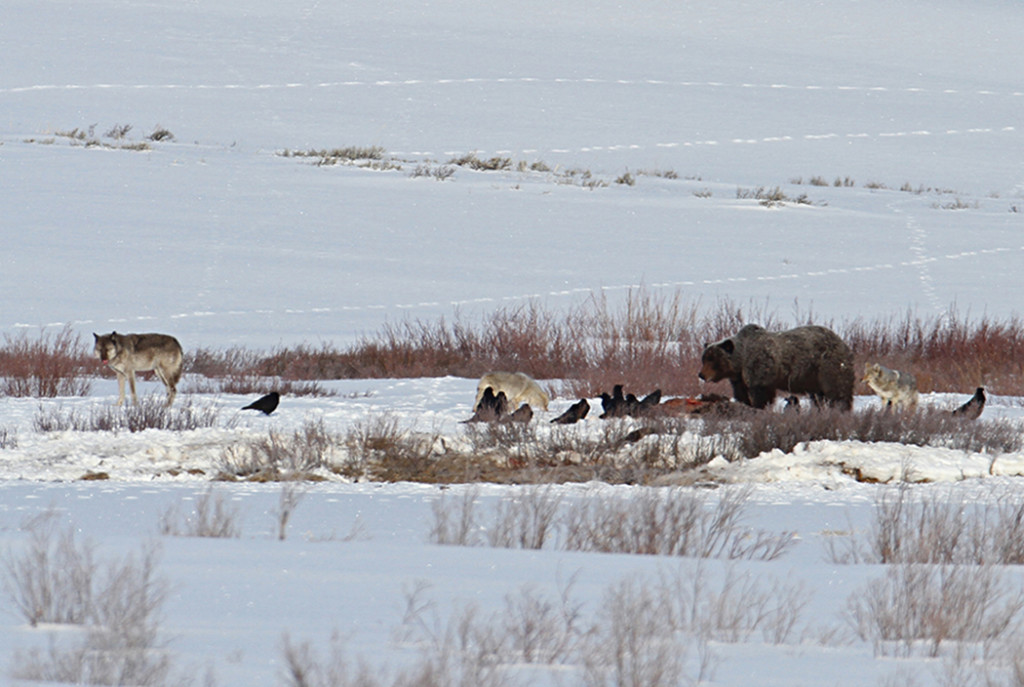
The Crow Goddess in Ancient Greece
March 4, 2016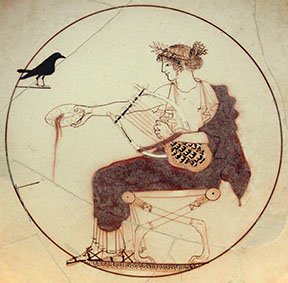
Another excerpt from my book-in-progress. Crows and ravens are conflated in ancient Greek myth.
A less familiar goddess who has a link with crows is Coronis. She is one of the Hyades, the seven sisters of light who are rain-makers. Olympic genealogy has her the parent with Apollo of the healing god Asclepius. She is also tied to Apollo in a story where the mistrustful Apollo sends a crow to spy on the goddess, and she does indeed cheat on him with another god. Apollo has Coronis bumped off by his sister and punishes his crow for not halting the liaison by changing him from white to black. This story accomplishes three things: 1) it solidifies Apollo’s ownership of the crow while denigrating the crow at the same time; 2) it explains why the god of light would have a black emblem; and 3) it justifies usurpation of the goddess’s cult by making her demise a result of her own betrayal. Reading into this story a bit, I would guess the unruly priestesses of Coronis resisted the cult of Apollo effectively for awhile.
The goddess Athena is believed to have turned Coronis herself from a white crow into a black crow. This is why the raven rests on the bust of Pallas in the Edgar Allan Poe narrative “The Raven.” Pallas is another name for Athena. The story goes that Coronis brought Athena some bad news, and the goddess in a rage changed the feathers of Coronis from white to black and banished her from the Acropolis. I disagree with those who categorize the crow as a familiar of Athena on the basis of this story. I think crows and ravens were banished from Athena’s temples because her priests wanted owls to nest there. Crows like to nest in high places (hence the term “crow’s nest”), and they mob owls. The purpose in the mobbing is to defend chicks and eggs from owl predation, and yet crows seem from our perspective to pursue owls with an unnecessary vehemence, seeming to attack them on principle. At any rate the two birds could not have cohabitated, so crows would have to be banished from Athena’s domain. In addition to firmly linking Coronis with the crow, this story again makes the crow an oracular bird.
Germanic Raven Goddesses
February 26, 2016The following is an excerpt from my book-in-progress about animal divination.
Despite being extremely social, ravens and crows squabble quite a bit between themselves, fighting over food and territory. They even, rarely, perform “executions,” a practice poorly understood though well documented. Corvids do not routinely harm members of their posse who are ailing and will even protect the disabled and bring them food. The dominant theory is that solitary birds with no allies eventually excite territorial instincts. Whatever the reason, the flock becomes very noisy as a number of birds execute the offender. Once killed, the cacophony abates suddenly and the birds abscond, leaving behind the corpse.
More common than executions of their own kind is mobbing of raptors. Any songbird might take part in a mobbing, but jays and crows are the most enthusiastic, while the larger and less vulnerable ravens seldom bother. Ravens do buzz and snap at eagles, perhaps to draw eagles away from nest sites (although this does not totally explain things). Some ravens hang out around wolf packs, waiting to devour leftovers from a carcass. In the meantime they enjoy teasing the wolves, pulling their tails and scampering off.
The raven-wolf pairing is more conspicuous in Germanic lore than the raven-horse, although both can be found. Two wolves sit at the feet of the god Odin, while two ravens flank his shoulders. The names of these ravens are Huginn and Muninn. usually translated as “thought” and “memory.” Odin the Allfather “sends them out at daybreak to fly over the whole world, and they come back at breakfast-time; by this means he comes to know a great deal about what is going on, and on account of this men call him the god-of-ravens.” There is some controversy over the meaning of “Muninn,” who is mentioned less frequently than his sidekick in extant Germanic lore. Two questions not entertained, to my knowledge, would be 1) Are these ravens really guy-ravens or is this a case of default male bias? and 2) Why two ravens?
The gender of the ravens does matter, since ravens are Odin’s servants and the Valkyries called the daughters of Odin, serve him on the battlefield as well as in Valhalla. In the Poetic Edda the battlefield is referred to as “Huginn’s grove,” so one or both of these same ravens are hovering alongside the fight like the Valkyries. Perhaps Huginn and Muninn are the culmination of a process from a dominant raven-goddess to a raven-goddess subsumed under rule of the Allfather to a subordinate raven deity stripped of feminine association.
That two wolves and two ravens flank Odin is curious. Why not one raven-wolf pair? Why not nine ravens? Two is not an automatically recurring number in Norse lore; nine, and occasionally three, are the most prominent numbers. If this were a story of Semitic origin I would attribute the pair of ravens to cultural emphasis on complementary halves, but that is not the case here. When Odin says he has two ravens, he means that the ravens are two, and we do have to ask, why two?
The idea that the mind of the God is divided into thought and memory is suspect, since this is a dualistic concept that, if it existed at all, would most probably have arisen through Christian influence. The translation of Muninn’s name as “memory” is contested anyway. There are marriages between gods and goddesses, which might explain the raven-pair, though marriages are often ways of blending the pantheons of conquerors with those of indigenous people, so a marriage might not fit with the idea of the ravens as vestiges of an earlier matriarchal cosmology. There are other deities that are commonly thought of in pairs, such as the goddess Frigga and her son Baldur, and the boar-goddess Freya with her boar-brother Freyr. Could Odin’s winged familiars be brother-sister raven deities?
Where the number two arises most frequently is in reference to the Aesir and Vanir, the two branches of pantheons that came together under the reign of the Odin. Feminist scholars theorize that these groups represent an indigenous Old European pantheon (the Vanir) linked to a conquering Indo-European pantheon (the Aesir) . We could also call them two allied Indo-European pantheons – the point is that they represent the confederation of two tribes. This would explain why Odin has two ravens and wolves at his command: they represent the raven-wolf totems of each of these tribes. This is supported by Odin’s revelation in the Prose Edda, “Over the world every day fly Hugin and Munin; I fear that Hugin will not come back, though I’m more concerned about Munin.” To me this speaks of a ruler trying to maintain control of an unruly alliance.
Sources
The Elder Eddas of Seamund Sigfusson, Benjamin Thorpe, trans, (London: Norroena Society) p. 143. Accessed at Project Gutenberg http://www.gutenberg.org/files/14726/14726-h/14726-h.htm February 22, 2016.
Marija Gimbutas, The Living Goddesses, (Berkeley, CA: University of California Press, 1999), p. 191.
Snorri Sturlson, The Prose Edda of Snorri Sturlson: Tales from Norse Mythology, Jean I. Young, trans. (Berkeley, CA: University of California Press, 2001), p. 64.
About Last Week…
February 19, 2016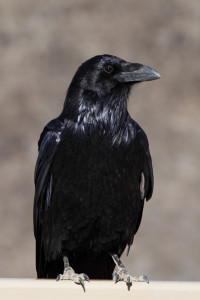
First let me reassure my readers that my promise to “eviscerate like an Irish satirist” was meant to be lighthearted. Some people didn’t get the joke, but I thought it was hilarious: it would be such a traditionally sound way to confront ultra-traditionalists. Ditto with my characterization of argumentative disagreement as “war”: that was an allusion to Morrigan.
I hope not too many times in the future to find myself in the position of explaining a joke, and I acknowledge that it’s a poor joke when people don’t get it. However, I can’t very well apologize for my criticisms (not that anyone has asked me to) since I didn’t level any – only telegraphed my intention. I’m glad it worked out this way, because now I know that the reaction had to do with my temerity to criticize rather than anything I would have said. I don’t hold animosity toward Pagan Reconstructionists, and as my readers know I value historical data as a way to inform practice. Having disagreements with Pagan Reconstructionism does not imply contempt or disregard for history, and it is precisely because this issue is framed in such a polarized way that there needs to be more critique. It may get ugly at times, but it needs to happen.
Sadly, my own critique will not be in verse. If you feel a need to comment on this post, I ask that you do that here rather than going to Facebook, so I can respond directly and publicly.
Review: The Morrigan by Morgan Daimler
February 12, 2016Following up on my post last month about Celtic raven goddesses, I wanted to review this book about the goddess Morrigan, who was mentioned in that post.
The Morrigan: Meeting the Great Queens by Morgan Daimler is another installment of the Moon Books Pagan Portals series. It is a short book, under a hundred pages, but contains in-depth material nonetheless. It discusses the Irish triple goddess from early Irish literary and historical sources. Other Irish goddesses associated with or mentioned in conjunction with the Morrigan are also explored. If you are looking for a way through the baffling and contradictory literature about these goddesses your hopes are dashed. Daimler mostly confirms that the sources really are that confused and confusing. Needless to say, this is not a book for the casual reader. Still, those who worship Irish goddesses and are drawn to Irish Paganism will find it worthwhile. There are invocations, meditations, and personal recollections that break up the text, as well as short essays on general topics related to the Morrigan such as “dark goddesses.”
The Morrigan is written from a Pagan Reconstructionist perspective, with the limitations and prejudices this implies. It hints at the tensions between fundamentalists and reformationists in modern practice, which I find interesting rather than off-putting. Usually this “discussion” consists of Reconstructionists sniping at non-Reconstructionists and non-Reconstructionists rolling their eyes and ignoring Reconstructionists. I’ve decided that the time has come for some pushback from the other team and will be unleashing some well overdue criticism against Reconstructionism in an article I am writing for an upcoming anthology. I will eviscerate the Reconstructionists with incisive commentary worthy of the old Irish satirists. Morrigan has spoken: the war is on.
Groundhog Medicine
February 5, 2016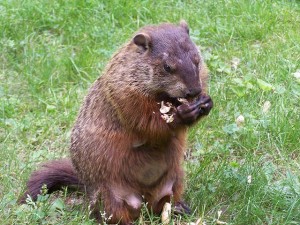
Another article of mine about the groundhog is up at Return to Mago. There is also a poem by Sara Wright and an essay by Jude Lally about Imbolc, and a video about Lammas for those down under by Glenys Livingtone.
The Groundhog Lady
January 29, 2016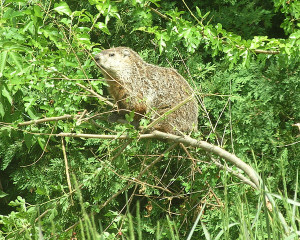
Animals that hibernate easily capture the imagination. What do they dream about during those long months? Groundhogs and other marmots are the queens of the long sleep, being some of the rare “true hibernators.” This means that unlike most creatures that sleep during the winter, they don’t wake up even once, surviving in suspended animation with vital signs like pulse, temperature and respiration becoming extremely low. They must remain in this state so their body fat will last until spring. Sometimes marmots starve during their hibernation and never wake at all.
Those who do come back carry messages from very far away. Groundhog power brings the ability to travel through the veil separating the worlds of the living and the dead. Trance work and meditation come effortlessly to those who cultivate groundhog energy. They enjoy being alone and draw power from retreat. At the same time, they do not permanently dwell in the shadows and will take their place in the sun.
The groundhog is a fitting symbol for the sun festival Imbolc, since she loves to bask in the sun. Yet there’s no electricity and no candles down in that bunker, so she maintains a hidden life. Imbolc is the time for nighttime initiations, when new priestesses receive secret teachings as they embark on the Path of the Wise. Those already initiated choose this time to rededicate themselves to their path, in recognition of the sun’s fulfillment of her promise of return. If you are a groundhog lady, you carry the occult qualities of this special day.
With their superb burrowing ability, groundhogs have the power to push past obstacles and remove stuck energy. The groundhog keeps a low profile, never bragging about her accomplishments, and as a result she is underappreciated. Gardeners bemoan the theft of vegetables without recognizing the role of burrowers in soil fertility. The masses of dirt are viewed as a nuisance without considering the how tunnels channel snow and water more efficiently. In the world of magic and psychic healing, where the major work is generally about moving blocked energies, the groundhog is a powerful ally that is usually overlooked, perhaps because she is small and unimpressive looking—cute rather than glamorous.
Some key words for groundhog magic are: elimination of obstacles, fulfillment of promises, communication with the dead, initiation, hidden meanings, meditation, vision, discernment, balanced view, change-making, earth moving.
Cultivating the Power of the Burrowing Rodent
January 22, 2016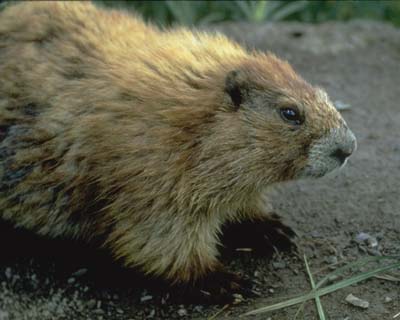
I can still remember my uncle sitting on his porch with a shotgun, determined to get the woodchuck that was decimating his garden. As I was very young, I marveled that he could sit quiet and still for such a long time. One man against one woodchuck. My money was on the woodchuck.
A woodchuck is a ground squirrel of the marmot family, also known as a groundhog and sometimes lumped into the catchall term for burrowing rodents, gopher, though technically a gopher refers to the Pocket Gopher of the northern Plains states. Whatever it is that answers to the name “gopher,” whether it’s a Pocket Gopher or a prairie dog or a groundhog or some other marmot, it’s still a vegetarian with a voracious appetite. Gophers decimate crops, compete with livestock for vegetation, and ruin vegetable gardens. They interfere with human engineering by piling up dirt where it isn’t wanted. Like all rodents, they sometimes carry diseases.
Gophers play an important role in the ecology, however, and eliminating gophers as pests causes many more problems than it solves. Their tunneling serves to channel snow and heavy rain back underground, reducing flash floods and standing water. They also aerate and enrich the soil, eliminating their waste underground and bringing deep soil to the surface. Foxes, snakes, skunks and many other small predators make their homes in abandoned groundhog houses, and these animals pray on mice and rats. (Foxes eat the groundhogs, too.) While prairie dogs do eat some of the same grasses as cattle or sheep, their foraging habits tend to diversify grassland, which actually benefits domestic animals. It’s only when prairie dog colonies explode that they cause a problem: prairie dog towns have been known to house several thousand pups over many acres of grassland. The rancher brought the prairie dog dilemma on himself, though, by exterminating the wolf and reducing coyote populations.
Prairie dogs live in “coteries” that will include a male and several females with their young, with the pups taking up residence close by. Quickly the town grows. Prairie dogs need to be highly social to manage life in a small town, and they communicate with a collection of chatter, whistles, clucks and barks that some linguists consider a true language. They also communicate by what looks like a kiss.
On the opposite end of the spectrum is the Pocket Gopher. Like most individuals who spend their free time in their apartments, the Pocket Gopher is a solitary creature. Mother kicks dad out of house soon after mating, and the youngsters mature quickly, then wander off.
Marmots are somewhere in between in sociability. The groundhog is monogamous, at least for a season, while the Western marmots live in harems. The youngsters like to box and wrestle. Marmot communication includes chatter, squeals, barks and a whistle that sounds a lot like a bird song. This gives marmots their other nickname of “whistle pigs.”
But marmots are not pigs and groundhogs are not hogs and prairie dogs are not dogs and, as mentioned before, it’s a bone of contention what is and isn’t a gopher. Even the word “woodchuck,” derived from an Algonquian word for another animal, is a misnomer, since they don’t chuck any wood. If you are allied with the burrowing squirrels, people will be confused about who you are or think they know who you are when they don’t.
The groundhog, like the snake, inhabits all three sections of the World Tree: the roots, the trunk, and the upper branches. Yes, groundhogs climb trees. They also swim. The ability to travel comfortably in many environments gives the groundhog, and women who cultivate groundhog energy, the power of discernment. They can understand the implication of events on many levels.

